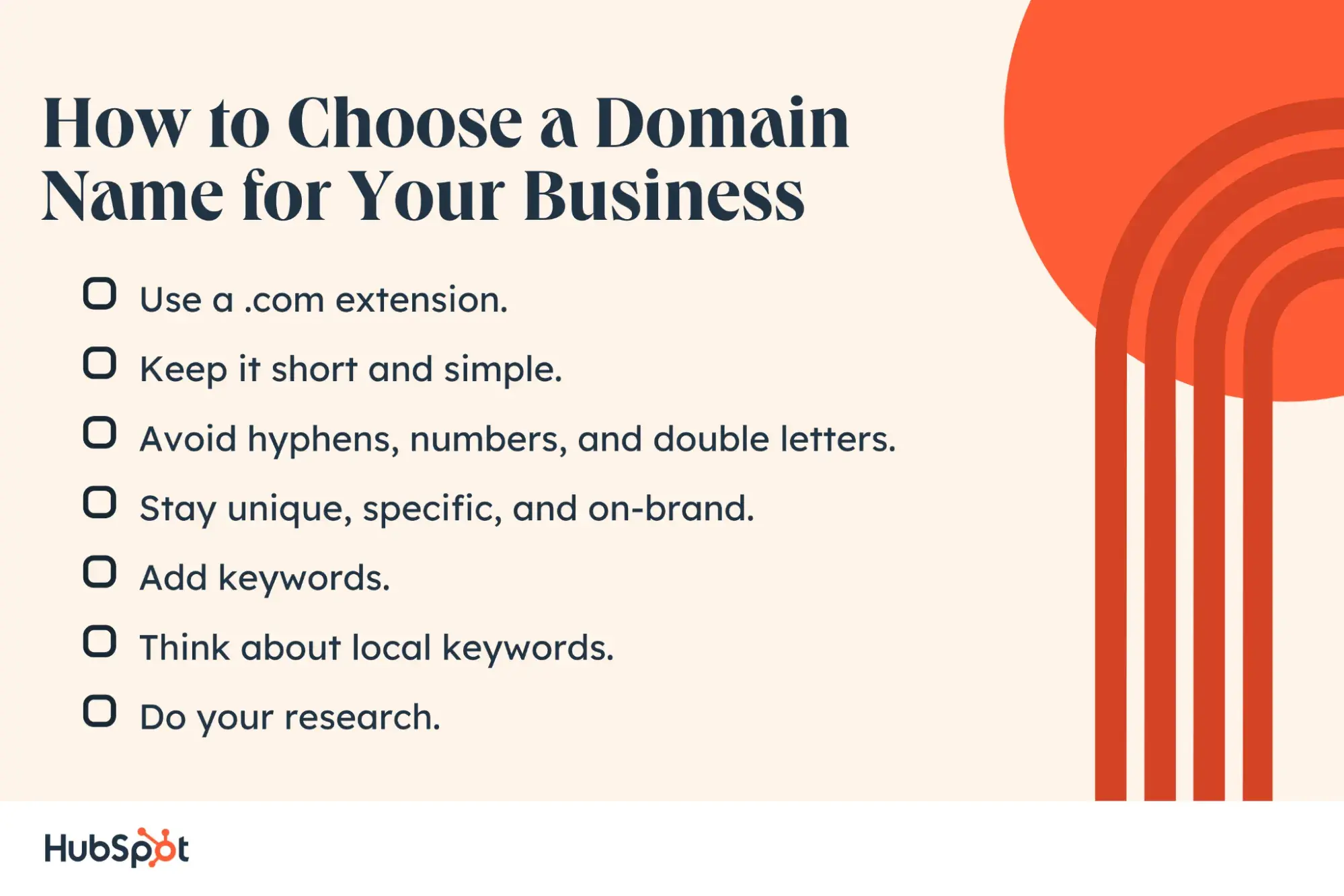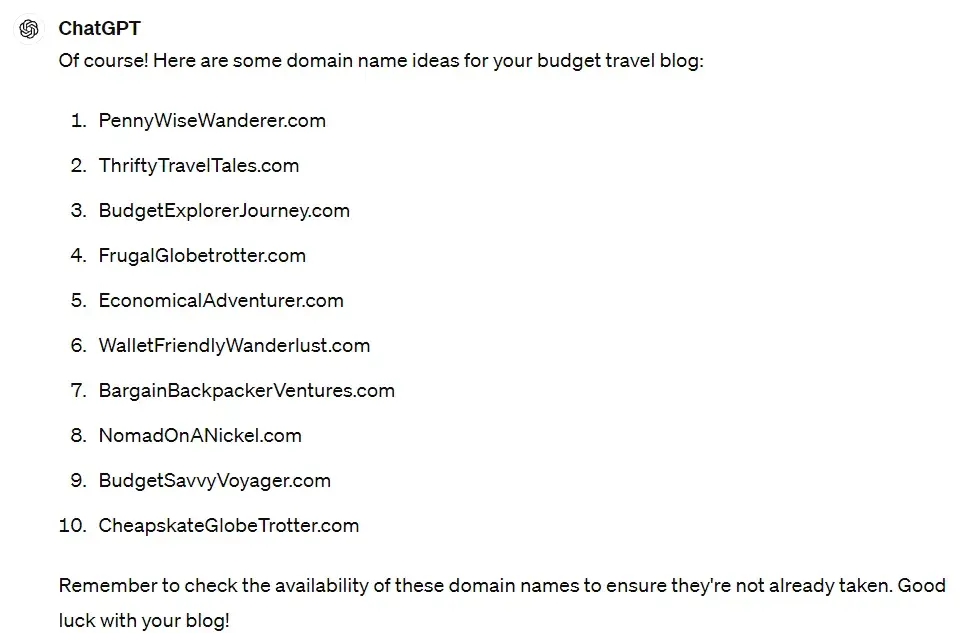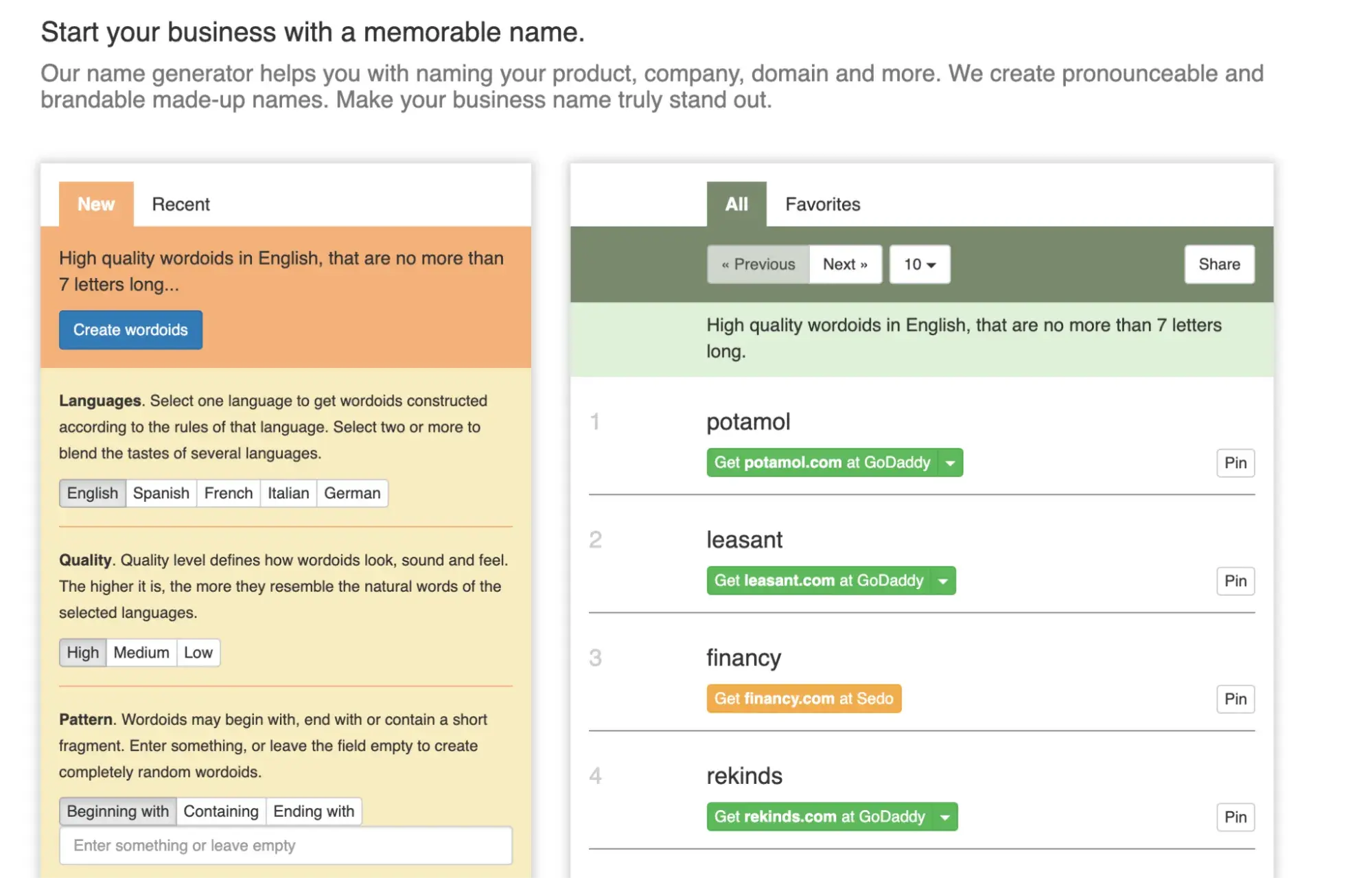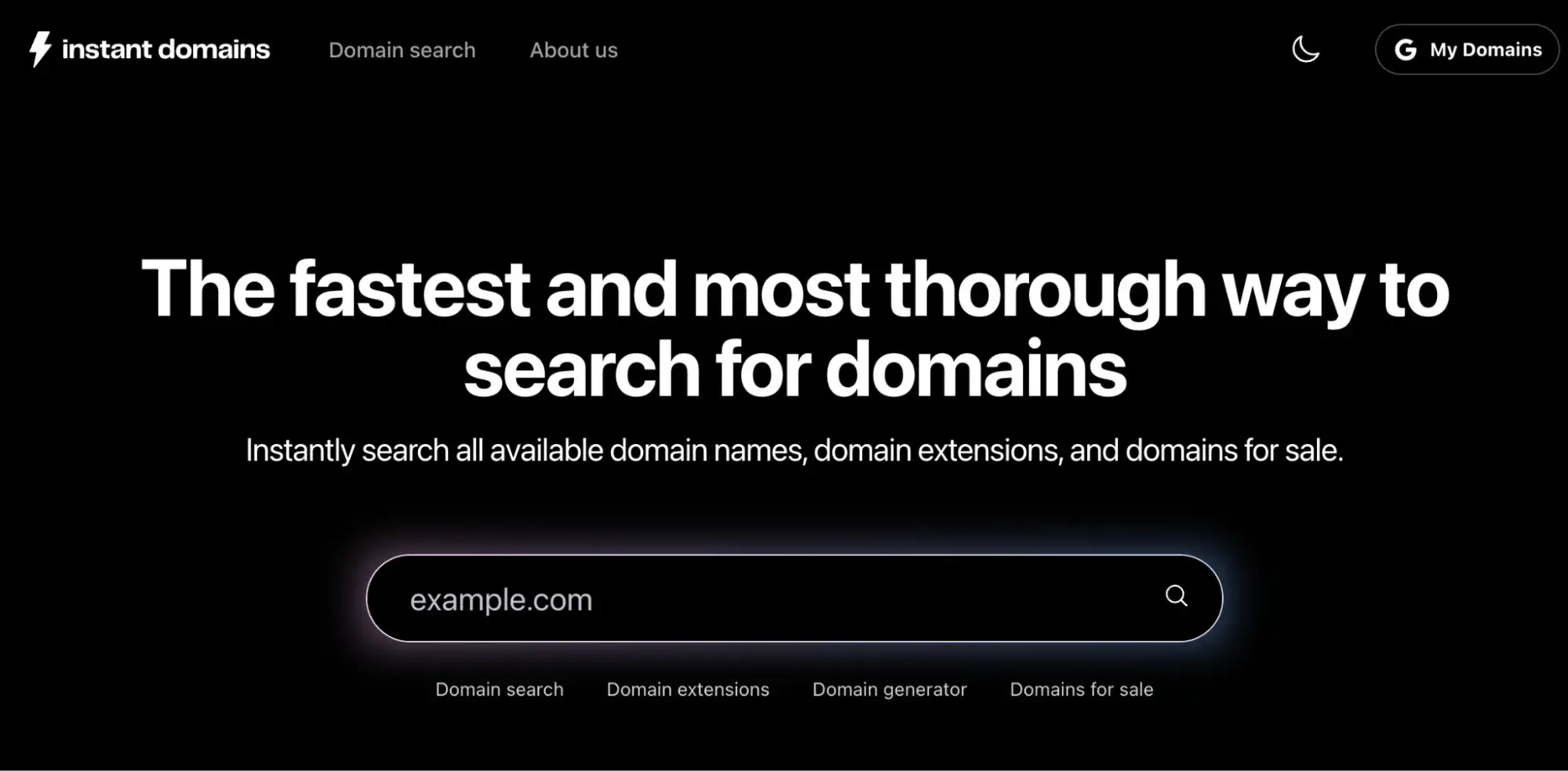Choosing the right domain name for your company is so important — ultimately, it’s how your audience will find and remember you.

The best domain is a custom domain that works for you. Sometimes, the best domain name for you might break some best practice rules. I’ve got websites built on domains that follow best practices, including those with keyword-rich domains, and other domains break the best practice rules big time; they’re even hard to spell.
With over 700 million domain names registered, it can be hard to find one that’s unique and functional. But, in this article, I’ll help you find a custom domain that will help your website stand out from the crowd and possibly even boost your SEO. I’ll help you choose and buy a domain while sharing the insights and tips I’ve learned along the way.
Table of Contents
- What Makes A Good Domain Name?
- How to Choose a Domain Name for Your Business
- How to Choose a Domain Name for Your Blog
- Domain Name Generator
- Establish Brand Identity by Picking the Perfect Domain Name
- What Makes A Good Domain Name?
- How to Choose a Domain Name for Your Business
- How to Choose a Domain Name for Your Blog
- Domain Name Generator
- Establish Brand Identity by Picking the Perfect Domain Name
What Makes A Good Domain Name?
The best domain names balance memorability, longevity, and sometimes SEO. There’s a lot to think about when choosing the right domain name, but before I get into all those steps, let’s first identify what makes a good domain.
Longevity
Ideally, you’ll pick one domain name you’ll stick with forever. This might seem scary, and it’s okay to change your domain later, but it’s better if you don’t — so don’t take this decision lightly.
The reason why longevity matters is because you want a domain name that’s stable to avoid confusing your audience.
There’s another lesser-known reason, and it’s related to SEO: a domain name builds authority. Basically, an older domain with high-quality content becomes trusted by Google and is theoretically easier to rank. The longer you spend with a domain and the more you build it up, the bigger the potential loss if you change it.
Again, you can change your domain, and there are lots of things you can do to protect that built authority, but the absolute best practice is to choose a domain that you can stick with.
SEO Considerations
As well as authority, your domain name can help bolster your SEO efforts. Domains including a keyword can help websites rank.
You want to balance the benefits of using the keyword in the URL against using a brand keyword. I’ll discuss the nuances of choosing keyword-rich domains later including when I think it’s appropriate and when to stay with the brand name.
Memorability
Your domain name is how your audience will find and remember you. The best domain names are memorable to your audience so they can easily find you again.
How to Choose a Domain Name for Your Business
If you are ready to establish a presence online for your business, you’ll want to choose a domain name that matches your brand. This way, customers can easily find and trust your site. There are a few steps you can keep in mind when choosing your domain name.

1. Use a .com extension.
You’ve surely visited many websites, and it’s not hard to see that the most popular domain extension is .com, while other trusted or common options include .org and .net.
In most cases, I would say, if .com is available, go with it. You might also want to buy other extensions to protect your brand name.
One thing to be mindful of: If someone already has the .com domain extension, you can still buy .co, .net, or whatever works, but it is worth considering broader implications. For example, you might end up with a trademark issue. If a .com domain extension is taken, it might be an indicator that you need a new domain altogether.
I worked with a small business that had an incredible social media following and sold thousands through its ecommerce website. However, after years of trading, it found itself in the midst of a trademark dispute and ended up having to change its domain and brand name. It was a big deal for the business. It survived, and everything is fine now, but it was a painful process that could’ve been avoided with a little foresight.
Pro tip: Most free website builders allow you to build a site for free but require a paid subscription to connect a custom domain. If you want a fully branded website, build yours on a CMS that allows you to connect a custom domain for free.
Testing it out.
When I bought the domain for my website, I used 123reg.co.uk to see if it was available. Here’s the process I followed.
Step 1. I checked whether my desired domain name was available.
I started by searching for my desired domain name on 123reg.co.uk. 123reg hosts most of my domains, but I also use GoDaddy. You can buy domains from loads of different places, but these two are my most trusted.
With GoDaddy and 123reg.com, the process is the same: Search your desired domain name in the search bar.

When I was choosing my domain name, I typed in www.forank.com, but to show you what happens when a domain name is available, I’ve created a fake domain name in the screenshot above. You can see it’s available with the co.uk extension. Usefully, 123reg offers you a bundle with different available domain extensions.
Step 2. I bought my desired domain name.
I was really pleased when www.forank.com was available for sale. However, there was a catch: The domain name was owned by someone, and I had to pay a few hundred dollars to get it. This wasn’t ideal, but I liked my chosen brand name, so I bought it. If the price had been too high, I would’ve had to think up a new brand name.
Step 3. I bought other domain extensions.
Since I’m from the U.K., I also bought www.forank.co.uk. The .co.uk domain redirects to the .com. I could’ve bought more — forank.io, forank.co, etc. — but this didn’t feel necessary for my small business and unique circumstances.
When choosing your domain extension, you want to be sensible about how many you buy and the extension you put the site on. I don’t recommend buying the recommended bundle just because you can. Think about the future and what you wouldn’t want people to have.
2. Keep it short and simple.
If your domain name is long, it’ll be harder for people to remember, which could spell out less traffic for you. WebsiteSetup.org recommends a domain name that is 6-14 characters in length.
Beyond that, a short domain name isn’t helpful if it is hard to spell or pronounce, as users will likely lose their way when trying to type your website URL.
Testing it out.
I’ve got three domains that I use to host sites, and they’re all of varying lengths.
I’ve already mentioned my boutique SEM agency, forank.com. The domain name is just six characters, but I’d argue it’s hard to spell.
I’ve got another domain, a blog with 11 characters, and another new domain with 20 characters. The longer domain breaks the rules when it comes to “short and simple,” but I believe it’s relevant and memorable, so I was happy to break that rule.
3. Avoid hyphens, numbers, and double letters.
Each of these elements is another hurdle for users to attempt to jump just to access your website. It’s not exactly intuitive to keep these characters in mind, and double letters can make the domain name messy and hard to read.
Not to mention, all of these elements are susceptible to becoming typos as users try to search the internet for your business website. If you’re sharing your website via word-of-mouth to clients, it’s also much harder to convey the domain name clearly when it is jumbled with hyphens, numbers, and the same letters back-to-back.
Testing it out.
My domain name, www.forank.com, is intended as a play on words: frank (like straight talking) and “for rank” (in that I’ll rank your website on Google). The trouble with it, outside of being hard to spell, is that people might write it “forrank.” To help reduce this problem, I also bought the forrank.co.uk domain and redirected it. The .com version was too expensive.
Pro tip: It’s all about weighing the pros and cons of your decisions. The main takeaway here is that you avoid deliberately misspelling your domain to get something that is technically already taken. This is bad practice for memorability, but you might end up with a domain dispute or trademark issue later. As aforementioned, if a domain name is taken, and you’re finding yourself trying a little too hard to secure it (e.g., buying unprofessional extensions or making spelling mistakes), it’s an indicator you need to think about something else.
.png)
Free Website Design Inspiration Guide
77 Brilliant Examples of Homepages, Blogs & Landing Pages to Inspire You
-
Agency Pages
-
Ecommerce Pages
-
Tech Company Pages
-
And More!
4. Stay unique, specific, and on-brand.
With all of these things to keep in mind, it can be hard to brainstorm a domain name that is clear and concise while also remaining unique and true to your business.
But it’s certainly doable. Keep your business name and what you sell at the forefront of your mind, and dig into your niche to ensure that your domain name attracts the online audience you want.
Testing it out.
I always find it hard to come up with domains. I usually have to go through a few versions of ideas and get knocked back a lot by the time I’ve searched its availability to find it’s taken.
Nowadays, I use ChatGPT to help me brainstorm domain name ideas. Using a fake scenario, here’s an example of what I’d ask ChatGPT.
I asked ChatGPT, “Can you help me come up with the best domain name for a new blog? I want to share my budget travel adventures.”
ChatGPT came up with some great starting points.

Helpfully, ChatGPT recommends checking the availability, which I did. Like any good domain, shorter versions (like thriftytravel) were taken on the .com extension but available on .co.uk. The point of this exercise is idea generation and inspiration.
Pro tip: You could develop my prompt and ask the generative AI not to include hyphens or double letters or to explore different extensions.
5. Add keywords.
I’m an SEO professional, so my opinion might surprise you here, but I don’t always recommend the keyword-rich domain.
From an SEO perspective, yes, a keyword-rich domain is the best domain, but SEO isn’t everything, and you don’t need a keyword-rich domain to rank well for your desired keywords.
You’ll rank just fine, eventually, without a keyword in the domain. I explore this more in the local section below.
Keywords can help a domain rank, but don’t prioritize them over your brand name. You want to strike a balance here.
hotels.com is a good example of a keyword-rich domain that doubles as a brand name.

The hotels.com scenario wouldn’t always work. For example, does Nike need to change its domain to “runningshoes.com”? I don’t think so.
Testing it out.
I’ve got one keyword-rich domain. It was created with keywords to help it rank, but what this domain name does well is double as a brand name, a bit like hotels.com. Basically, it was a lucky find, and the stars aligned, so I seized it.
My main website and business, forank.com, isn’t optimized, yet it is the website that makes me the most money. I could’ve gone for “zoeseoconsultant.com” if I wanted something heavy on SEO, but that’s not really catchy, is it? It also wouldn’t have the longevity I wanted because I’m not a solo consultant anymore.
My blog domain, roadtoframe.com, is all about cycling. It’s fun and memorable and a play on the “road to fame.” If I wanted a keyword-rich domain, I might’ve gone for cyclingstories.com, or cyclingtravel.com, but keywords aren’t everything.
Road to Frame makes a passive income every single month. It also ranks for thousands of keywords and earns over a million impressions every three months.
Keywords really aren’t everything, so don’t choose keywords over a common-sense brand name.
6. Think about local keywords.
If you’re serving a local area or a country, you might want to choose a domain with the country code domain extension.
Expedia uses .com.[country-code], such as in https://www.expedia.com.au/. The Australian version of their site has the local country code level domain (CCLD).
In theory, this will help them rank the right site in the right country, but there’s a lot more that goes into this. If ranking in other countries is a priority, I’d speak to an SEO about the best way to manage this.
Another tact for serving local areas is to have the area in your domain name. Here’s an example:

Rite Plumbing and Heating serves New York only, so they’ve added “NYC” to their domain name. To be fair, a search for “plumber New York” brings them to the top spot on Google. Within the same search, I also found Star NYC Plumber, which also uses the location in the domain name.
Here’s the thing, though: Locations in the domain name aren’t everything. Roto-Rooter does not use the location in their domain. Instead, they use landing pages for the location, such as https://www.rotorooter.com/manhattan/, so you can find a way to rank either way.
Testing it out.
Remember when I said I bought the .co.uk version of my brand name because I am based in the U.K.? This is what I mean. I could’ve hosted my site on the .co.uk version, but I chose not to because .com felt a bit more “worldwide” to me, and I serve clients all over the globe.
If you’re a business based in the U.K. and serving people in the U.K., you might prefer the co.uk version.
7. Do your research.
Aside from keyword research, there’s nothing worse than dreaming up what seems like the perfect domain name only to find yourself in hot water for unknowingly infringing on a trademarked domain.
Ensure your chosen domain is truly original to you to avoid dealing with legal troubles and the painstaking process of finding yet another unique, SEO-friendly domain name.
How to Choose a Domain Name for Your Blog
Like finding a domain name for a business, choosing a domain name for your blog has many similar steps. But because businesses can start offline, you might not even have a name chosen for your blog yet!
Luckily, this means you have a better chance of finding a blog name and domain name that are a perfect match, but you’ll need to put in some elbow grease to find something unique. According to Master Blogging, there are more than 600 million blogs on the internet. But don’t be discouraged! Here are some steps to help you find the right domain name for you.
1. Consider domain extensions.
As stated above, .com is the top domain extension for you to consider. For a blog, you might want to get creative with some of the newer, creative options, but your content will be easiest to find if you stick with a classic, common domain extension. Go for .com if you can, then move on to other popular options like .net or .co.
2. Avoid vague or generic options.
While you want a clear, easy-to-remember domain name, you also don’t want it to be so basic that it is lost in the shuffle. Opt for something catchy, memorable, and brandable.
3. Ensure your domain is unique.
Outside of just being punchy and memorable, your blog domain should be unique. Make sure it represents your brand and content while also standing out from competitors.
For example, HubSpot is certainly unique and comes to mind quickly. It’s easy to type, spell, and pronounce. It might not have succeeded with a more generic name like marketinghub.com, marketingonline.com, or marketinginformation.com. In fact, if you search “marketing,” HubSpot is one of the top options — but more generic domain names are nowhere to be found.
4. Capture keywords.
If you’d like an SEO boost right from the start, you can incorporate keywords into your domain name.
Of course, make sure this doesn’t sacrifice the length, originality, or brand integrity of your blog, but if there are keywords that would play well with another short, unique word or two, consider adding them to your domain name.
5. Make it easy to type and pronounce.
Sure, your blog name is unique, but if no one knows how to pronounce it or type it as a URL, your traffic numbers might suffer as a result.
If a domain name is confusing, it’s more likely that users will have typos and get lost as they try to find your blog. Make it easy for them, and avoid hurting your traffic numbers, by choosing a simple, clear domain name.
6. Move quickly.
With millions of domain names online today — and additional names getting registered every minute — once you’ve decided on the best domain name, don’t hesitate to register it.
You can learn more about setting up a domain name with the free HubSpot course, "WordPress Training Course: Learn How to Build a WordPress Website Using Elementor," which can help you get your website established and your domain set up quickly and simply.
Domain names are hot commodities, but they are also pretty affordable. As long as your idea isn’t trademarked or already in use, grab it before it’s gone! You can always change it later if you decide it just isn’t working.
.png)
Free Website Design Inspiration Guide
77 Brilliant Examples of Homepages, Blogs & Landing Pages to Inspire You
-
Agency Pages
-
Ecommerce Pages
-
Tech Company Pages
-
And More!
Domain Name Generator
I understand that this is a lot to digest. But just as there are generators to help you find excellent hashtags and keywords, there are also tools to help you find domain names (in addition to using ChatGPT).
You can take some of the keywords and brand-related words you’ve brainstormed through the above tips and add them to a domain name generator, which will use those words and related words to create lists of available domain names.
Even if you don’t pick a domain name exactly from the generator, it can help inspire your team to find a domain name that is perfect for your business or blog. Here are some of the top domain name generators to try.
1. Wordoid

If you have one word that you just keep coming back to, try typing it into Wordoid, which will give you ideas that contain that word. Wordoid also focuses on domains that are around 10 characters, although you can set a character limit from 5 to 15 if you have a length in mind.
2. Looka

Looka’s Business Name Generator can generate dozens of business names by abstract idea (like creativity) and industry. It will automatically check if domain names and social names are available — and if they’re not, offer alternatives. It will also include a few logo ideas so you can get your website up and running as quickly as possible.
3. Nameboy

The oldest domain generator on the internet, Nameboy is a trusted, popular source for finding an original domain name. Enter one or two keywords, and Nameboy brings up a list of unique options to choose from. Nameboy also has specific generators for blog names, brand names, and business names, among others, all of which could work hand-in-hand with your search for a domain name.
4. IsItWP

The IsItWP domain name generator is a simple, straightforward, and fast tool to help you turn a brand name and keywords into a unique and effective domain name. It’s also integrated with BlueHost, so if you find a domain name you love, you can register it right away for free if you use BlueHost to host your website.
5. Instant Domain Search

Instant Domain Search is another easy-to-use option that generates ideas as you type. This domain generator will show available domains as well as taken options that are available for sale.
Establish Brand Identity by Picking the Perfect Domain Name
Your domain name might seem like a minor detail in the grand scheme of creating a website, but it reflects your business to potential customers or audiences right away.
If it’s long or confusing, many people will never be able to find your business or blog site. If your domain name doesn’t match or at least complement your brand name, it can come across as unprofessional or even spammy.
On the flip side, a well-researched and thought-out domain name can boost your rankings in search engine results and provide audiences with a clear idea of what to expect when they visit your site. As such, it’s important to take the time to find a domain name that is just right for you.
Editor's note: This post was originally published in December 2020 and has been updated for comprehensiveness.










